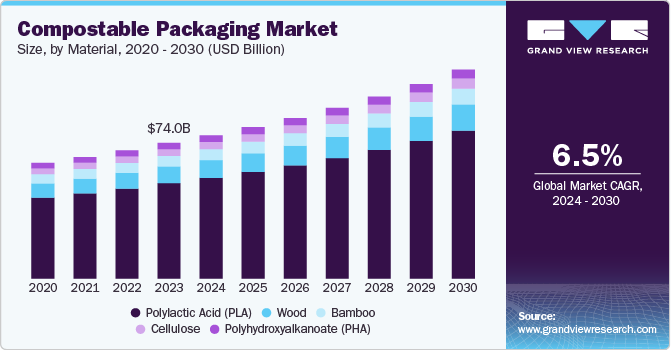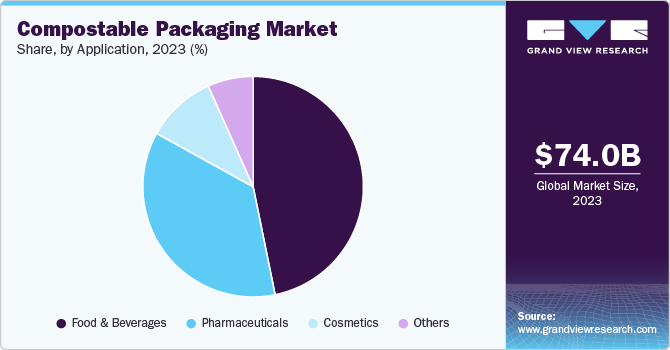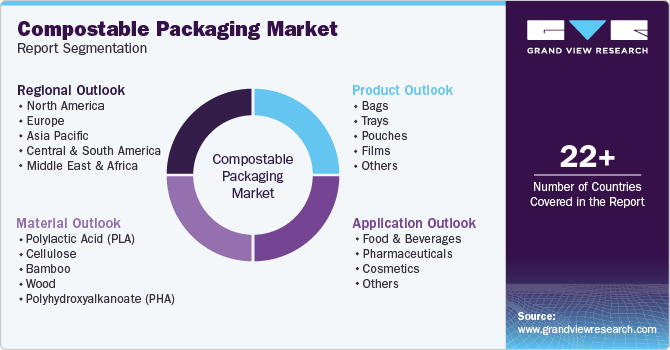- Home
- »
- Plastics, Polymers & Resins
- »
-
Compostable Packaging Market Size & Share Report, 2030GVR Report cover
![Compostable Packaging Market Size, Share & Trends Report]()
Compostable Packaging Market (2024 - 2030) Size, Share & Trends Analysis Report By Material (Cellulose, Bamboo), By Application (Cosmetics, Pharmaceuticals), By Product, By Region, And Segment Forecasts
- Report ID: GVR-4-68040-474-2
- Number of Report Pages: 150
- Format: PDF
- Historical Range: 2018 - 2022
- Forecast Period: 2024 - 2030
- Industry: Bulk Chemicals
- Report Summary
- Table of Contents
- Segmentation
- Methodology
- Download FREE Sample
-
Download Sample Report
Compostable Packaging Market Summary
The global compostable packaging market size was valued at USD 74.01 billion in 2023 and is projected to reach USD 113.88 billion by 2030, growing at a CAGR of 6.5% from 2024 to 2030. The market growth is driven by a combination of environmental concerns, regulatory frameworks, consumer preferences, and advancements in material science.
Key Market Trends & Insights
- North America dominated the global market in 2023 and accounted for the largest revenue share.
- Asia Pacific is expected to register the fastest growth rate during the forecast period.
- By material, polylactic acid (PLA) held the largest market share of over 70.0% in 2023.
- By product, pouches accounted for more than 33.0% of the global revenue share in 2023.
- By end use, the food & beverages segment led the market with the highest revenue contribution in 2023.
Market Size & Forecast
- 2023 Market Size: USD 74.01 Billion
- 2030 Projected Market Size: USD 113.88 Billion
- CAGR (2024–2030): 6.5%
- North America: Largest market in 2023
- Asia Pacific: Fastest growing market
Government regulations and policies are another significant driver for this market. Many countries and regions are imposing strict regulations on single-use plastics and encouraging the use of compostable alternatives. For instance, the European Union’s Single-Use Plastics Directive has set restrictions on plastic packaging, which has led to increased adoption of compostable packaging. Similarly, cities across the U.S., including New York and San Francisco, have introduced bans on non-compostable plastics, creating a favorable regulatory environment for compostable packaging manufacturers.
In addition, corporate social responsibility (CSR) initiatives by businesses play a key role in driving the adoption of compostable packaging. Companies are increasingly recognizing the importance of sustainability in their branding and operations. Packaging is often the most visible aspect of a product, and shifting toward compostable materials allows companies to showcase their commitment to environmental stewardship. For instance, brands like Lush and Pangea Organics use compostable packaging as part of their broader sustainability strategies, appealing to environmentally conscious consumers while aligning with CSR goals.
Finally, technological advancements in material science have improved the performance and cost-efficiency of compostable packaging, further fueling market growth. Innovations in biopolymers, such as polylactic acid (PLA) and polyhydroxyalkanoates (PHA), have made it possible for compostable packaging to match the durability and functionality of traditional plastics. This has opened new possibilities for industries like food & beverage, cosmetics, and consumer goods, which rely heavily on packaging solutions. With continued research and development, the cost gap between conventional plastics and compostable materials is narrowing, making compostable packaging a viable option for mass-market applications.
Material Insights
Based on material, the market has been segmented into polylactic acid (PLA), cellulose, bamboo, wood, and polyhydroxyalkanoate (PHA). PLA dominated the overall market with a revenue market share of over 70.0% in 2023 and is expected to witness robust growth with a CAGR of 6.6% over the forecast period. It is a biopolymer derived from renewable resources such as corn starch or sugarcane. PLA is widely used in compostable packaging products due to its ease of processing and relatively low cost. PLA offers good mechanical properties and is transparent, making it versatile for different applications.
The wood material segment is expected to grow at the fastest CAGR during the forecast period. Wood-based packaging materials, such as molded fiber or paper products, are commonly used in packaging applications. Wood is naturally compostable and can be transformed into various packaging forms, including cartons, trays, and cushioning materials. It offers structural strength and is suitable for both food and non-food applications.
Product Insights
Based on product, the market has been segmented into bags, trays, pouches, films, and others. Pouches dominated the overall market with a revenue market share of over 33.0% in 2023. The increasing demand for convenient and sustainable packaging in the food and beverage industry is driving the adoption of compostable pouches. Compostable pouches are flexible, lightweight packaging options commonly used for snacks, coffee, grains, and other dry food items. These pouches can be manufactured using plant-based materials such as polylactic acid (PLA) and paper laminates.
Compostable films are expected to grow at the fastest CAGR during the forecast period. These thin, flexible sheets are used as protective packaging for food products, consumer goods, and industrial applications. They are often made from materials like PLA, polyhydroxyalkanoates (PHA), or starch-based polymers. Compostable films degrade naturally under composting conditions and are used for wraps, laminates, and coatings.
Application Insights
Based on the application, the market is segmented into food & beverages, pharmaceuticals, cosmetics, and others. Food & beverages dominated the market and accounted for the largest revenue share of over 46.0% in 2023. This positive outlook is due to the growing demand for sustainable food packaging options, stringent regulations on single-use plastics, and consumer preference for environmentally friendly brands. Besides, the rise of e-commerce and food delivery services has increased the need for compostable packaging, further fueling demand in this segment.

In the pharmaceutical sector, compostable packaging is gaining momentum as companies strive to minimize their environmental footprint while maintaining the integrity and safety of their products. Packaging in this industry must meet high standards to ensure drug stability, protection, and compliance with health regulations, and compostable materials are being designed to meet these requirements. Moreover, the cosmetics industry progressively adopts compostable packaging to align with natural and eco-conscious beauty product trends. Packaging for cosmetics, which often involves multiple layers and materials, is being reimagined with biodegradable and compostable options to reduce environmental harm.
Regional Insights
The compostable packaging market in North America has a well-established waste management infrastructure. Moreover, the growing emphasis on composting programs has also contributed to market growth. Cities such as San Francisco, Seattle, and Portland have implemented mandatory composting laws, requiring residents and businesses to separate organic waste. This has led to an increased demand for compostable packaging that can collect and dispose of organic waste without contaminating the composting process. In addition, many grocery stores, restaurants, and other businesses in North America are voluntarily adopting compostable packaging products, such as bags, pouches, and films, as part of their sustainability initiatives, further driving market expansion.
U.S. Compostable Packaging Market Trends
The U.S. compostable packaging market is growing due toincreasing environmental awareness and concern about plastic pollution. Many U.S. cities and states have implemented bans or restrictions on single-use plastic bags, creating a demand for alternative solutions. For example, California banned single-use plastic bags statewide, while cities such as New York and Chicago have followed suit. This legislative push has encouraged consumers and businesses to seek more eco-friendly options, including compostable packaging.
Europe Compostable Packaging Market Trends
Europe dominated the market and accounted for the largest revenue share of over 43.0% in 2023. Europe has emerged as a leader in driving the compostable and packaging market due to a combination of stringent environmental regulations, growing consumer awareness, and government initiatives. The European Union has implemented several directives to reduce plastic waste and promote sustainable alternatives. For instance, the EU Plastics Strategy, adopted in 2018, sets targets for all plastic packaging to be recyclable or reusable by 2030. This has created a strong incentive for businesses and consumers to switch to more environmentally friendly options such as compostable packaging products.
The UK compostable packaging market is primarily driven by stringent regulations to reduce plastic waste and promote sustainable alternatives. For instance, the UK Plastics Pact, launched in 2018, set ambitious targets for eliminating problematic plastics and increasing the use of recyclable, reusable, or compostable packaging. This regulatory push has incentivized manufacturers and retailers to invest in compostable packaging options. Major supermarket chains like Tesco and Sainsbury's have begun offering compostable bags for fruit and vegetables.
Asia Pacific Compostable Packaging Market Trends
The compostable packaging market in Asia Pacific is growing due to rapid urbanization. The growing middle class contributes to higher waste generation rates, particularly in Indonesia, Vietnam, and the Philippines. This has led to a greater need for effective waste management solutions, including biodegradable refuse bags. For example, Jakarta, Indonesia's capital, produces around 7,000 tons of waste daily, creating a significant market opportunity for eco-friendly waste disposal products.
China compostable packaging market is expected to grow significantly due to increasing environmental awareness and stricter regulations. As the world’s largest consumer of plastics, China has been under pressure to manage its waste effectively. In recent years, the Chinese government has implemented strict regulations and policies to reduce single-use plastics, including bans on non-degradable plastic bags in major cities. The 2020 nationwide ban on non-degradable plastic bags for all major urban areas, including shopping malls and restaurants, created a significant demand for alternative, eco-friendly materials, including compostable packaging products such as bags, trays, films, and pouches.
Key Compostable Packaging Company Insights
The market's competitive environment is shaped by a growing emphasis on sustainability, driving innovation among established and emerging players. Key companies lead the market with advanced biodegradable materials and a strong focus on R&D. Smaller; niche manufacturers are also entering the space, leveraging regional demand for eco-friendly alternatives. The market is highly fragmented, with players differentiating through product certifications, material sourcing, and sustainability standards. Intense competition is driven by consumer preference for environmentally friendly products and increasing government regulations encouraging sustainable waste management solutions.
Key Compostable Packaging Companies:
The following are the leading companies in the compostable packaging market. These companies collectively hold the largest market share and dictate industry trends.
- TIPA Ltd
- Rocktenn
- Ultra-Green Sustainable Packaging
- Özsoy Plastik
- International Paper Company
- Mondi
- SmartSolve Industries
- Tetra Pak International SA
- Amcor plc
- DS Smith
- Klabin SA
- WestRock Company
- Hosgör Plastik
- Smurfit Kappa
- Rengo Co. Ltd
- Stora Enso
- BASF SE
- Bemis manufacturing company
- Clearwater Paper Corporation
- Eurocell S.r.l
Recent Developments
-
In January 2024, Sealed Air launched its new CRYOVAC brand compostable overwrap tray at the International Product & Processing Expo (IPPE) 2024, marking a significant advancement in sustainable packaging for protein products. This innovative tray is designed as a biobased alternative to traditional expanded polystyrene (EPS) trays.
-
In September 2024, Pakka Ltd., a major compostable packaging company, launched a new range of compostable flexible packaging solutions aimed at the Fast-Moving Consumer Goods (FMCG) industry. This initiative represents a significant step in addressing environmental concerns related to packaging waste, particularly in India.
Compostable Packaging Market Report Scope
Report Attribute
Details
Market size value in 2024
USD 78.05 billion
Revenue forecast in 2030
USD 113.88 billion
Growth rate
CAGR of 6.5% from 2024 to 2030
Actual data
2018 - 2023
Forecast period
2024 - 2030
Quantitative units
Volume in kilotons, revenue in USD million/billion, and CAGR from 2024 to 2030
Report coverage
Volume Forecast, revenue forecast, competitive landscape, growth factors and trends
Segments covered
Material, product, application, region
Regional scope
North America; Europe; Asia Pacific; Central & South America; Middle East & Africa
Country Scope
U.S.; Canada; Mexico; Germany; UK; France; Italy; Spain; China; India; Japan; Brazil; Argentina; Saudi Arabia; South Africa; UAE
Key companies profiled
TIPA Ltd; Rocktenn; Ultra-Green Sustainable Packaging; Özsoy Plastik; International Paper Company; Mondi; SmartSolve Industries; Tetra Pak International SA; Amcor plc; DS Smith; Klabin SA; WestRock Company; Hosgör Plastik; Smurfit Kappa; Rengo Co. Ltd; Stora Enso; BASF SE; Bemis manufacturing company; Clearwater Paper Corporation; Eurocell S.r.l
Customization scope
Free report customization (equivalent up to 8 analyst’s working days) with purchase. Addition or alteration to country, regional & segment scope
Pricing and purchase options
Avail customized purchase options to meet your exact research needs. Explore purchase options
Global Compostable Packaging Market Report Segmentation
This report forecasts volume & revenue growth at global, regional, and country levels and provides an analysis of the latest industry trends in each of the sub-segments from 2018 to 2030. For this study, Grand View Research has segmented the global compostable packaging market report based on material, product, application, and region:

-
Material Outlook (Volume, Kilotons; Revenue, USD Million, 2018 - 2030)
-
Polylactic Acid (PLA)
-
Cellulose
-
Bamboo
-
Wood
-
Polyhydroxyalkanoate (PHA)
-
-
Product Outlook (Volume, Kilotons; Revenue, USD Million, 2018 - 2030)
-
Bags
-
Trays
-
Pouches
-
Films
-
Others
-
-
Application Outlook (Volume, Kilotons; Revenue, USD Million, 2018 - 2030)
-
Food & Beverages
-
Pharmaceuticals
-
Cosmetics
-
Others
-
-
Regional Outlook (Volume, Kilotons; Revenue, USD Million, 2018 - 2030)
-
North America
-
U.S.
-
Canada
-
Mexico
-
-
Europe
-
Germany
-
UK
-
France
-
Italy
-
Spain
-
-
Asia Pacific
-
China
-
India
-
Japan
-
-
Central & South America
-
Brazil
-
Argentina
-
-
Middle East & Africa
-
Saudi Arabia
-
UAE
-
South Africa
-
-
Frequently Asked Questions About This Report
b. The global market for compostable packaging was estimated at USD 74.01 billion in 2023 and is expected to reach USD 78.05 billion in 2024.
b. The global market for compostable packaging is expected to grow at a compound annual growth rate of 6.5% from 2024 to 2030, reaching around USD 113.88 billion by 2030.
b. PLA dominated the overall market with a revenue market share of over 70.0% in 2023. It is a biopolymer derived from renewable resources such as corn starch or sugarcane. PLA is widely used in compostable packaging products due to its ease of processing and relatively low cost.
b. Some of the key players in compostable packaging include TIPA Ltd; Rocktenn; Ultra-Green Sustainable Packaging; Özsoy Plastik; International Paper Company; Mondi; SmartSolve Industries; Tetra Pak International SA; Amcor plc; DS Smith; Klabin SA; WestRock Company; Hosgör Plastik; Smurfit Kappa; Rengo Co. Ltd; Stora Enso; BASF SE; Bemis manufacturing company; Clearwater Paper Corporation; Eurocell S.r.l.
b. The compostable packaging market is driven by a combination of environmental concerns, regulatory frameworks, consumer preferences, and advancements in material science.
Share this report with your colleague or friend.
Need a Tailored Report?
Customize this report to your needs — add regions, segments, or data points, with 20% free customization.

ISO 9001:2015 & 27001:2022 Certified
We are GDPR and CCPA compliant! Your transaction & personal information is safe and secure. For more details, please read our privacy policy.
Trusted market insights - try a free sample
See how our reports are structured and why industry leaders rely on Grand View Research. Get a free sample or ask us to tailor this report to your needs.










